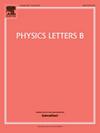利用重、轻反应系统中的粒子发射比探索重离子碰撞中的强子-夸克相变
IF 4.5
2区 物理与天体物理
Q1 ASTRONOMY & ASTROPHYSICS
引用次数: 0
摘要
基于同时包含强子自由度和夸克自由度的AMPT模型,我们研究了40Ca+40Ca、48Ca+48Ca和197Au+197Au反应系统中的λ、kaon、质子和先驱的产生。研究发现,重反应体系和轻反应体系中相同粒子的发射比,特别是奇异粒子Λ0或K+在重反应体系和轻反应体系中的发射比,对重离子碰撞中的强子-夸克相变非常敏感。本文给出了这些结果的详细解释和验证。本文章由计算机程序翻译,如有差异,请以英文原文为准。
Exploring hadron-quark phase transition in heavy-ion collisions using particle emission ratios in heavy and light reaction systems
Based on the AMPT model, which incorporates both hadronic and quark degrees of freedom, we studied the productions of lambda, kaon, proton, and pion in reaction systems 40Ca+40Ca, 48Ca+48Ca, and 197Au+197Au. It is found that the ratios of identical particle emissions from heavy and light reaction systems, especially the emission ratios of strange particles or K+ in heavy and light reaction systems, are highly sensitive to the hadron-quark phase transition in heavy-ion collisions. Detailed explanations and validations of these results are given.
求助全文
通过发布文献求助,成功后即可免费获取论文全文。
去求助
来源期刊

Physics Letters B
物理-物理:综合
CiteScore
9.10
自引率
6.80%
发文量
647
审稿时长
3 months
期刊介绍:
Physics Letters B ensures the rapid publication of important new results in particle physics, nuclear physics and cosmology. Specialized editors are responsible for contributions in experimental nuclear physics, theoretical nuclear physics, experimental high-energy physics, theoretical high-energy physics, and astrophysics.
 求助内容:
求助内容: 应助结果提醒方式:
应助结果提醒方式:


